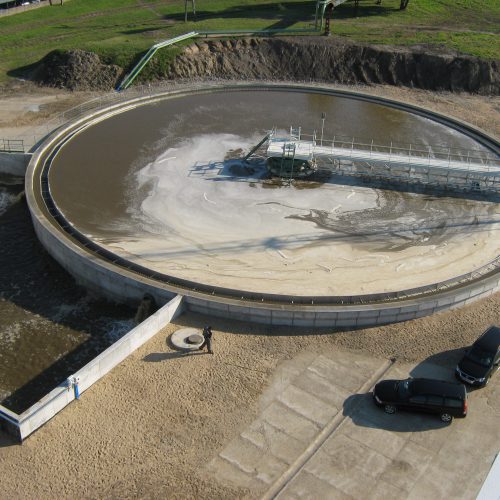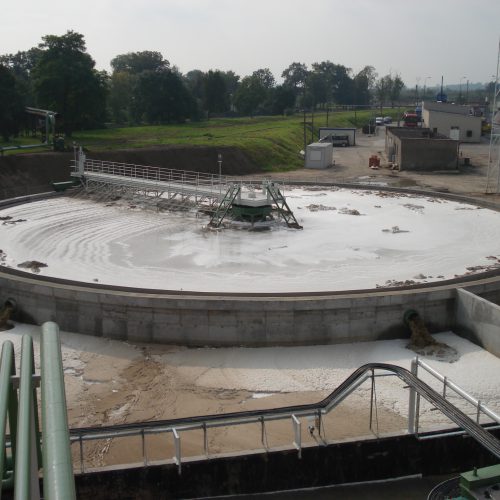Settling basin
Description of the process:
During beet processing, all dirt particles that were delivered with the beets are removed while floating in and during water washing. Any impurities that are not removed in the existing drum and belt type rock catcher and grave catcher remain in the water. For mechanical water treatment, our settling basins are, in addition to low operational costs, the most effective treatment plants for waste water. If the waste water has a high sand content or small organic particle, we recommend installing our rake clarifier followed by a flume water filter into the water cycle. The rake clarifier separates sand particles and therefore reduces the load on the round sedimentation tanks. Post-liming of the flume water is reduced and costs can therefore be lowered.
Settling basins description:
The settling basin is used for mechanical water treatment. The operating costs of this water purification equipment are very low for a very effective purification of the waste water. The size of the settling basin depends on the amount of waste water to be cleaned. Settling basins of up to 80 m in diameter have already been installed in some sugar refineries.
The settling basin consists of the following modules:
Scraper bridge with
- Undercarriage as a support structure with drive unit
- Boom with adjustable grill
- Slurry pump with suction tube
- Turning and centring unit
- Optional – floating debris separator
- Sprinkler device for foam suppression-> Concrete basins
- Central support foundation
- Slurry pits
- Tank base
- Overflow edge
- Ditches
- Outside bearing ring for scraper bridgeThe contaminated waste water is passed centrally through a pipe below the surface of the water into the round settling basin. Due to the large volume of the basin, the water flows very slowly and evenly to the surrounding overflow rim, which is segmented around the entire diameter of the basin.
Solid particles, which have different rates of descent based on their individual properties, sink to the bottom of the settling basin. Sandy particles immediately sink very rapidly after introducing the water into the settling basin. Silt and clay particles require considerably more time to reach the bottom. Due to the quickly sinking parts entering the settling basin, the slurry pit is also positioned immediately in front of the central water delivery point. As the entire scraper bridge turns, the settled particles are conveyed to the slurry pit by means of sturdy rakes.
The slurry pit, which is below the base, has suction applied to it through a nozzle, which is connected to a sludge pump, and the slurry is taken to the slurry pond or treated at a filter- press station. The treated water flows over the overflow edge and is carried to a reservoir via water trenches or immediately used for floating in and washing the beets.
The speed of the scraper bridge is variable and can be adjusted to different operating conditions. Where the water quality is very poor, flocculants and foam oil are also added to the wash water. Optionally, an additional sprinkler can be installed on the scraper bridge in order to reduce foam build-up.
In addition, a floating debris separator can be installed directly before the overflow on the scraper bridge in order to remove floating debris such as foliage, wood and organic matter from the surface of the water. These parts can be discharged sideways, next to the tank.



